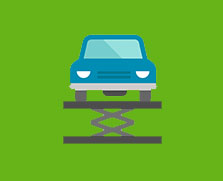Land Rover Defender MOT Results
Registered in 201769.2% pass rate
from 247 tests in 2021
(140% worse than other 2017 cars)
More MoT Results
Failure rates by item
Here you can drill down into the failure rates for each item on the test. We've also compared the rates to the average results for 2017 cars and highlighted areas where the Land Rover Defender is unusually good or bad.
-
15% fail on
Lamps, reflectors and electrical equipment
(4 times worse than other 2017 cars)
-
8.1% fail on
Headlamp aim
(5 times worse than other 2017 cars)
- 8.1% fail on Headlamp aim (5 times worse than other 2017 cars)
-
2.8% fail on
Front and rear fog lamps
(18 times worse than other 2017 cars)
-
2.8% fail on
Rear fog lamp
(18 times worse than other 2017 cars)
- 2.8% fail on Rear fog lamp (18 times worse than other 2017 cars)
-
2.8% fail on
Rear fog lamp
(18 times worse than other 2017 cars)
- 2.4% fail on Stop lamp (6 times worse than other 2017 cars)
-
2.0% fail on
Headlamps
(3 times worse than other 2017 cars)
- 2.0% fail on Headlamp (3 times worse than other 2017 cars)
-
2.0% fail on
Direction indicators
(7 times worse than other 2017 cars)
-
2.0% fail on
Flashing type
(7 times worse than other 2017 cars)
- 0.81% fail on Individual direction indicators (12 times worse than other 2017 cars)
- 0.81% fail on Side repeaters
- 0.40% fail on All direction indicators
-
2.0% fail on
Flashing type
(7 times worse than other 2017 cars)
- 0.81% fail on Registration plate lamp(s)
-
0.81% fail on
Electrical equipment
(14 times worse than other 2017 cars)
- 0.81% fail on Horn (27 times worse than other 2017 cars)
-
8.1% fail on
Headlamp aim
(5 times worse than other 2017 cars)
-
6.1% fail on
Visibility
- 3.6% fail on Wipers
- 2.8% fail on Washers (190% worse than other 2017 cars)
- 0.40% fail on Bonnet
-
5.3% fail on
Brakes
(150% worse than other 2017 cars)
-
2.0% fail on
Brake performance
(3 times worse than other 2017 cars)
-
1.6% fail on
Service Brake Efficiency (sp)
(25 times worse than other 2017 cars)
-
1.6% fail on
Rbt (sp)
(27 times worse than other 2017 cars)
- 1.2% fail on Service brake performance (45 times worse than other 2017 cars)
- 0.40% fail on Service brake imbalance
-
1.6% fail on
Rbt (sp)
(27 times worse than other 2017 cars)
-
0.81% fail on
Service brake performance
-
0.81% fail on
Rbt
- 0.81% fail on Service brake performance
- 0.40% fail on Service brake imbalance
-
0.81% fail on
Rbt
-
1.6% fail on
Service Brake Efficiency (sp)
(25 times worse than other 2017 cars)
- 1.6% fail on Rigid brake pipes (97 times worse than other 2017 cars)
-
1.6% fail on
Mechanical brake components
-
0.81% fail on
Brake linings and pads
- 0.81% fail on Brake pads
-
0.40% fail on
Brake discs and drums
- 0.40% fail on Brake discs
-
0.40% fail on
Brake cables, rods, levers and linkages
- 0.40% fail on Lever
-
0.81% fail on
Brake linings and pads
-
0.40% fail on
Brake actuators (including spring brakes or hydraulic cylinders)
- 0.40% fail on Hydraulic brake callipers
-
0.40% fail on
ABS / EBS / ESC
- 0.40% fail on Anti-lock braking system
-
2.0% fail on
Brake performance
(3 times worse than other 2017 cars)
-
4.9% fail on
Suspension
(4 times worse than other 2017 cars)
- 1.6% fail on Wheel bearings (28 times worse than other 2017 cars)
-
1.6% fail on
Suspension arms
(6 times worse than other 2017 cars)
- 1.2% fail on Pins and bushes (8 times worse than other 2017 cars)
- 0.81% fail on Ball joint dust cover (31 times worse than other 2017 cars)
-
1.2% fail on
Anti-roll bars
(7 times worse than other 2017 cars)
- 0.81% fail on Linkage ball joints (12 times worse than other 2017 cars)
- 0.40% fail on Linkage
- 0.40% fail on Linkage pins and bushes
- 0.81% fail on Shock absorbers (6 times worse than other 2017 cars)
-
0.40% fail on
Suspension rods
- 0.40% fail on Pins and bushes
- 0.40% fail on Component mounting prescribed areas
-
4.5% fail on
Steering
(28 times worse than other 2017 cars)
-
4.0% fail on
Steering linkage components
(38 times worse than other 2017 cars)
- 2.4% fail on Ball joint (514 times worse than other 2017 cars)
- 1.6% fail on Drag link end (870 times worse than other 2017 cars)
- 1.2% fail on Track rod end (12 times worse than other 2017 cars)
-
0.40% fail on
Steering gear
- 0.40% fail on Steering box
-
4.0% fail on
Steering linkage components
(38 times worse than other 2017 cars)
-
4.5% fail on
Body, chassis, structure
(13 times worse than other 2017 cars)
- 1.2% fail on Exhaust system (15 times worse than other 2017 cars)
-
1.2% fail on
Transmission
(10 times worse than other 2017 cars)
-
1.2% fail on
Prop shafts
(223 times worse than other 2017 cars)
- 0.81% fail on Joints (207 times worse than other 2017 cars)
- 0.40% fail on Prop shaft
-
1.2% fail on
Prop shafts
(223 times worse than other 2017 cars)
-
0.81% fail on
Doors
(23 times worse than other 2017 cars)
-
0.81% fail on
Other passenger's door
(51 times worse than other 2017 cars)
- 0.81% fail on Door condition (53 times worse than other 2017 cars)
-
0.81% fail on
Other passenger's door
(51 times worse than other 2017 cars)
-
0.81% fail on
Seats
(43 times worse than other 2017 cars)
- 0.40% fail on Driver's seat
- 0.40% fail on Passenger's seat
-
0.40% fail on
Integral vehicle structure
- 0.40% fail on Integral vehicle structure condition
-
2.8% fail on
Noise, emissions and leaks
(4 times worse than other 2017 cars)
-
2.0% fail on
Exhaust emissions
(2 times worse than other 2017 cars)
-
2.0% fail on
Compression ignition
(8 times worse than other 2017 cars)
- 0.81% fail on Malfunction indicator lamp
- 0.40% fail on Pre 01/07/2008 Turbo
- 0.40% fail on Pre 01/07/2008 Non turbo
- 0.40% fail on On or after 01/01/2014
-
2.0% fail on
Compression ignition
(8 times worse than other 2017 cars)
-
0.81% fail on
Fluid leaks
(35 times worse than other 2017 cars)
- 0.81% fail on Engine oil leaks (44 times worse than other 2017 cars)
-
2.0% fail on
Exhaust emissions
(2 times worse than other 2017 cars)
-
1.6% fail on
Tyres
- 1.2% fail on Condition
- 0.40% fail on Tread depth
-
1.2% fail on
Identification of the vehicle
(4 times worse than other 2017 cars)
- 1.2% fail on Registration plates (4 times worse than other 2017 cars)
-
0.40% fail on
Seat belts and supplementary restraint systems
-
0.40% fail on
Seat belts
- 0.40% fail on Condition
-
0.40% fail on
Seat belts




